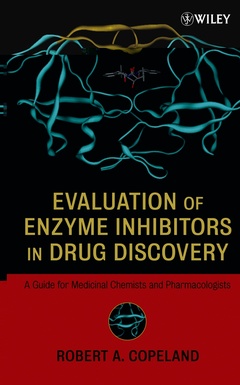Description
Evaluation of enzyme inhibitors in drug discovery : A guide for medicinal chemis ts & pharmacologists (Methods of biochemical analysus Volume 46)
Author: COPELAND Robert A.
Language: English
Subjects for Evaluation of enzyme inhibitors in drug discovery : A...:
Approximative price 123.10 €
Subject to availability at the publisher.
Add to cart272 p. · Hardback
Description
/li>Contents
/li>
Preface.
Acknowledgments.
1. Why Enzymes as Drug Targets?
1.1 Enzymes Are Essentials for Life.
1.2 Enzyme Structure and Catalysis.
1.3 Permutations of Enzyme Structure During Catalysis.
1.4 Other Reasons for Studying Enzymes.
1.5 Summary.
References.
2. Enzyme Reaction Mechanisms.
2.1 Initial Binding of Substrate.
2.2 Noncovalent Forces in Reversible Ligand Binding to Enzymes.
2.2.1 Electrostatic Forces.
2.2.2 Hydrogen Bonds.
2.2.3 Hydrophobic Forces.
2.2.4 van der Waals Forces.
2.3 Transformations of the Bond Substrate.
2.3.1 Strategies for Transition State Stabilization.
2.3.2 Enzyme Active Sites Are Most Complementary to the Transition State Structure.
2.4 Steady State Analysis of Enzyme Kinetics.
2.4.1 Factors Affecting the Steady State Kinetic Constants.
2.5 Graphical Determination of kcat andK<,sub>,M
2.6 Reactions Involving Multiple Substates.
2.6.1 Bisubstrate Reaction Mechanisms.
2.7 Summary.
References.
3. Reversible Modes of Inhibitor Interactions with Enzymes.
3.1 Enzyme Inhibitor Binding Equilibria.
3.2 Competitive Inhibition.
3.3 Noncompetitive Inhibition.
3.3.1 Mutual Exclusively Studies.
3.4 Uncompetitive Inhibition.
3.5 Inhibition Modality in Bisubstrate Reactions.
3.6 Value of Knowing Inhibitor Modality.
3.6.1 Quantitative Comparisons of Inhibitor Affinity.
3.6.2 Relating K<,sub>,i to Binding Energy.
3.6.3 Defining Target Selectivity by K<,sub>,i Values.
3.6.4 Potential Advantages and Disadvantages of Different Inhibition Modalities In Vivo.
3.6.5 Knowing Inhibition Modality Is Important for Structure Based Lead Organization.
3.7 Summary.
References.
4. Assay Considerations for Compound Library Screening.
4.1 Defining Inhibition Signal Robustness, and Hit Criteria.
4.2 Measuring Initial Velocity.
4.2.1 End Point and Kinetic Readouts.
4.2.2 Effects of Enzyme Concentration.
4.3 Balanced Assay Conditions.
4.3.1 Balancing Conditions for Multisubstrate Reactions.
4.4 Order of Reagent Addition.
4.5 Use of Natural Substrates and Enzymes.
4.6 Coupled Enzyme Assays.
4.7 Hit Validation and Progression.
4.8 Summary.
References.
5. Lead Optimization and Structure Activity Relationships for Reversible Inhibitors.
5.1 Concentration Response Plots and IC<,sub>,50 Determination.
5.1.1 The Hill Coefficient.
5.1.2 Graphing and Reporting Concentration Response Data.
5.2 Testing for Reversibility.
5.3 Determining Reversible Inhibition Modality and Dissociation Constant.
5.4 Comparing Relative Affinity.
5.4.1 Compound Selectivity.
5.5 Associating Cellular Effects with Target Enzyme Inhibition.
5.5.1 Cellular Phenotype Should Be Consistent with Genetic Knockout or Knockdown of the Target Enzyme.
5.5.2 Cellular Activity Should Require a Certain Affinity for the target Enzyme.
5.5.3 Buildup of Substrate and/or Diminution of Product for the Target Enzyme Should Be Observed in Cells.
5.5.4 Cellular Phenotype Should Be Reversed by Cell Permeable Product or Downstream Metabolites of the Target Enzyme Activity.
5.5.5 Mutation of the...




